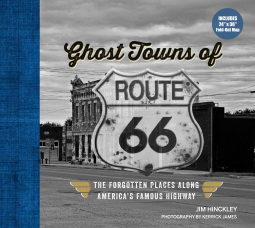Sour Americana. [Ghost Towns of Route 66 by Jim Hinckley]
The quintessential boom-and-bust highway of the American West, Route 66 once hosted a thriving array of boomtowns built around oil mines, railroad stops, cattle ranches, resorts, stagecoach stops, and gold mines. Illustrated with gorgeous sepia-tone and color photography by Kerrick James, this book tours dozens of ghost towns in: Illinois (Braidwood, Braceville, Gardner, Dwight, Bloomington, Funks Grove, Springfield)Missouri (Rolla, Dootlittle, Springfield, Halltown, Paris Springs Junction, Avilla, Carthage, Joplin)Kansas (Galena, Riverton, Baxter Springs)Oklahoma (Narcissa, Afton, Tulsa, Warwick, Bridgeport, Foss, Elk City, Erick, Texola)Texas (Shamrock, McLean, Alanreed, Jericho, Amarillo, Glenrio)New Mexico (San Jon, Tucumari, Montoya, Newkirk, Cuervo, Dilia, Tecolote, Santa Fe, Thoreau, Gallup)Arizona (Lupton, Chambers, Two Guns, Flagstaff, Truxton, Hackberry, Kingman, Goldroad, Oatman)California (Needles, Goffs, Essex, Cadiz, Chambless, Amboy, Ludlow, Newberry Springs, Daggett, Barstow)
This edition also includes directions and travel tips for your ghost-town explorations along Route 66, as well as a fold-out map of the Mother Road.
Explore the beauty and nostalgia of these abandoned communities along America’s favorite highway!
The idea, the fact of ghost towns is one I find so intriguing. In a world where claims of overpopulation and limited resources are made, where homelessness and wealth inequality are so pervasive, ghost towns sparkle a queer brilliance for obvious reasons. So my eagerness to read Jim Hinckley's Ghost Towns of Route 66 was quite real. Structure of towns just exist, lying empty, awaiting new opportunity or the TLC of a willing investor. Even just areas in decline, awaiting a boom of bodies. But then I think of the history and the social realities behind these areas. The social, ethnic, political realities, and suddenly, especially in the case of these communal relics, I find myself cursing the towns.
I wanted to learn of the ghost towns of Route 66, a highway I had no idea had changed so many times over, changing with it the fabric of these encampments. But why would these towns be important to me? Many of them had their heyday in the '20s or the '50s and '60s, some reaching prosperity as early as the late 1800s. How would I, a Black woman, have been accepted in these towns then? Would I be accepted in the surviving areas now? A lot of the mainland United States seems a terror to me. The thought of white supremacists lurking everywhere, the idea of being trapped by land as far as the eye sees, a rural existence behind modernity because of lazy or unwilling politicians, lawless vigilantism and murders never seeing justice - this is what I think of when I contemplate not living on the coast. Admittedly, a lot of those fears are realities on the coast as well, but when you take it into account as a comprehensive dream it's a terror!
So ignoring the sour taste for the nostalgic Americana dream that visiting the history of these towns dredges up, I don't think this book was meant for me. I don't drive, let's start with that. The farthest west I've been has been Las Vegas, Nevada and that was by flight. I knew nothing about the history of U.S. Route 66 before this read, so though that was a fun positive, I was really caught unawares by what was assumed I did know. What was missing most for me was a standard definition of ghost town. What is the population threshold for a ghost town? Is there one? Or at least what did the author use to qualify these towns as ghost towns? I think had I read with that in mind the experience would have been much different.
As I read the impression I got was that there exist a subculture of travel aficionados who frequent the old route and spend a great deal of their free time doing the whole touristy thing. Again, not something I see myself ever doing, worries for safety or not. But this book felt most appropriate for that audience. For me, I most enjoyed the history of the towns and how their fortunes went terrible wrong as soon as a road was moved. Seemingly obvious, that's not something I would have ever considered. The real takeaway is never to center your economy on something as unreliable as foot traffic. 3 stars from me.
Ghost Towns of Route 66 is due for publication October 27, 2020.

Comments
Post a Comment